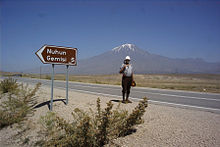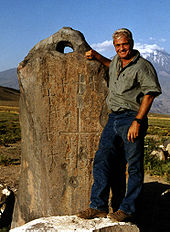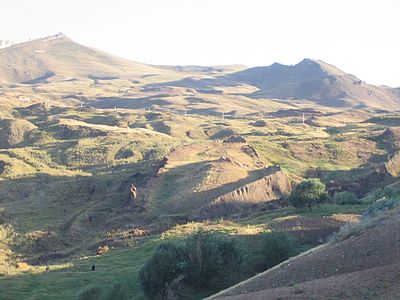- Durupınar site
-
Coordinates: 39°26′26.26″N 44°14′04.26″E / 39.4406278°N 44.2345167°E
The Durupınar site is a large aggregate structure in the Mount Tendürek of eastern Turkey. The site is 3 kilometres (2 mi) north of the Iranian border, 16 km (10 mi) southeast of Doğubeyazıt, in the Ağrı Province, and eighteen miles (29 km) south of the Greater Mount Ararat summit, at an elevation of 6,449 ft (1,966 m) ~ 6,575 ft (2,004 m)[1] above sea level.
The size and shape of the structure has led to its promotion by some believers as the original Noah's Ark. To mainstream scientists[2] and most creationists,[3] this is merely an interesting natural formation.
The site is near several officially unnamed peaks, though locals call one of the nearby peaks Mount Judi (Turkish Cudi Dağı, Kurdish Çîyaye Cûdî), the mountain named in the Qur'an as the final resting place of Noah's Ark.[4] Most scholars believe that Qur'anic Mount Judi is a different mountain near the Turkish/Iraqi border.[5][unreliable source?]
Contents
Discovery and exploration
 An official road sign along the Silk Road in Turkey with the words Nuhun Gemisi, or "Noah's Ship," pointing the way to the Durupınar site and away from Mount Ararat.
An official road sign along the Silk Road in Turkey with the words Nuhun Gemisi, or "Noah's Ship," pointing the way to the Durupınar site and away from Mount Ararat.
According to local reports, heavy rains combined with three earthquakes exposed the formation from the surrounding mud in May 1948.[6] It was subsequently identified by Turkish Army Captain İlhan Durupınar - for whom it was subsequently named - in a Turkish Air Force aerial photo while on a mapping mission for NATO in October 1959. Durupınar informed the Turkish government of his discovery and a group from the Archeological Research Foundation which included George Vandeman, İlhan Durupınar, and Arthur Brandenberger, professor of photogrammetry, surveyed the site in September 1960. After two days of digging and dynamiting inside the "boat-shaped" formation the expedition members found only soil and rocks. Their official news release concluded that "there were no visible archaeological remains" and that this formation "was a freak of nature and not man-made".
The site was then ignored until 1977, when it was rediscovered and promoted by self-styled archaeologist and amateur explorer Ron Wyatt. Throughout the 1980s Wyatt repeatedly tried to interest other people in the site, including ark hunter and former astronaut James Irwin and creationist John D. Morris, neither of whom were convinced the structure was the Ark.[7]
In 1985, Wyatt was joined by David Fasold and geophysicist John Baumgardner for the expedition recounted in Fasold's The Ark of Noah. As soon as Fasold saw the site, he exclaimed that it was a ship wreck.[8] Fasold brought along state-of-the-art ground-penetrating radar equipment and a device called a frequency generator, set it on the wavelength for iron, and searched the formation for internal iron loci (the latter technique was later compared to dowsing by the site's detractors).[9] The ground penetration radar yielded a regular internal structure as documented in a report to the Turkish government. Fasold and the team measured the length of the formation 538 ft (164 m), close to the 300 cubits (157 m, 515 ft) of the Noah's Ark in the Bible if the Ancient Egyptian cubit of 20.6 inches (0.52 m) is used.[10][11] Fasold believed the team found the fossilized remains of the upper deck and that the original reed substructure had disappeared. In the nearby village of Kazan (formerly Arzap), so-called drogue (anchor) stones that they believed were once attached to the ark were investigated.
After a few expeditions to the Durupınar site that included drillings and excavation in the 1990s, Fasold began to have doubts that the Durupınar formation was Noah's ark. He visited the site in September 1994 with Australian geologist Ian Plimer and concluded that the structure was not a boat.[11] He surmised that ancient peoples had erroneously believed the site was the ark.[11][12][13] In 1996 Fasold co-authored a paper with geologist Lorence Collins entitled "Bogus 'Noah's Ark' from Turkey Exposed as a Common Geologic Structure" which concluded that the boat-shaped formation was a curious upwelling of mud that merely resembled a boat.[13] In April 1997, during sworn testimony during an Australian court case, Fasold repeated his doubts and noted that he regarded the claim that Noah's ark had been found as "absolute BS".[14][15][16]
Others such as fellow ark researchers Don Patten and David Allen Deal, reported that before his death Fasold returned to a belief that the Durupınar site might be the location of the ark.[17] His close Australian friend and biographer June Dawes wrote:
He [Fasold] kept repeating that no matter what the experts said, there was too much going for the [Durupınar] site for it to be dismissed. He remained convinced it was the fossilized remains of Noah's Ark.[18]
Arzap Drogue Stones
 From [1] - David Fasold, a promoter of the Durupınar site, stands with a Drogue Stone (crosses are believed to have been added later).
From [1] - David Fasold, a promoter of the Durupınar site, stands with a Drogue Stone (crosses are believed to have been added later).
The Arzap Drogue Stones are a number of large standing stones found near the Durupınar site by amateur archaeologist Ron Wyatt with the aid of David Fasold and others. Fasold interpreted the artifacts as drogues, stone weights used to stabilize the Ark in rough seas, on the grounds that they all have a chamfered hole cut at one end as if to fasten a rope to them,[19] and because the existence of such stones was suggested by his reading of the Epic of Gilgamesh, the Babylonian mythical account of the flood.[20]
Drogue stones were a feature of ancient ships, and were the ancient equivalent of a storm anchor. They have been found in the Nile and elsewhere in the Mediterranean area, and like the stones found by Wyatt and Fasold, they are heavy and flat with a hole for connecting a line at one end. Their purpose was to create drag in the water or along shallow sandy bottoms: the stone was attached to one end of a boat, and the drag produced would cause the bow or stern to face into the wind and the oncoming wind-blown waves.[19].
A geological investigation of samples from the stones, published by geologist Lorence Collins in co-authorship with their original discoverer David Fasold, suggested that they are formed of local rock and thus unlikely to have been transported to the site from Mesopotamia, the Ark's supposed place of origin.[21] Similar stones are found throughout ancient Armenia, and are recognised to be pagan "holy stones" converted to Christian use (many are found in Christian cemeteries) by the addition of crosses and other Christian symbols.[22]
See also
- Searches for Noah's Ark
- Mount Ararat
- Ararat anomaly
- Deluge (mythology)
- Flood geology
- Gilgamesh flood myth
- Pareidolia
References
- ^ Specialtyinterests.net - The remains of Noah's Ark
- ^ Noah's Ark
- ^ Special report: Amazing ‘Ark’ exposé
- ^ Fasold, among others, notes that the local Kurds refer to one of the local peaks as Cudi, see Fasold, David (1988). The Ark of Noah. New York: Wynwood. pp. 92–93. ISBN 0922066108. Sura 11:044 from the Marmaduke Pickthall translation of the Qur'an: "And it was said: O earth! Swallow thy water and, O sky! be cleared of clouds! And the water was made to subside. And the commandment was fulfilled. And it (the ship) came to rest upon (the mount) al Cudi and it was said: A far removal for wrongdoing folk!"
- ^ See Noah'sArkSearch.com
- ^ David Fasold, The Ark of Noah, (New York: Wynwood, 1988), pp. 319-325. See also [http://www.noahsarksearch.com/reshit.htm Edwin B. Greenwald, "Turk Reports 'Ship' Atop Mt. Ararat," Associated Press article, 13 November 1948.
- ^ The Ark of Noah, "Durupınar Site" from NoahsArkSearch.com, June Dawes, Noah's Ark: Adrift in Dark Waters, (Belrose, NSW: Noahide, 2000).
- ^ The Ark of Noah, p. 7.
- ^ That Boat-Shaped Rock … Is it Noah’s Ark?
- ^ The Ark of Noah, pp. 15-22 and others.
- ^ a b c Pockley, Peter (6 November 1994). "Theory blown out of the water". Australian Sun-Herald.
- ^ The Main Points about the "Noah’s Ark Trial" and Ian Plimer
- ^ a b Collins, L. D. and Fasold, D. (1996). Bogus 'Noah's Ark' from Turkey Exposed as a Common Geologic Structure. Journal of Geoscience Education 44, 439—444
- ^ Clifton, Brad (9 April 1997). "Doubts sank faith in Ark". The Daily Telegraph (Australia).
- ^ Thomson, Kirstyn (9 April 1997). "Witness Tells How Ark Faith Sank". The West Australian.
- ^ Finkel, Elizabeth (18 April 1997). "Creationism Suit: Australian Geologist Battles 'Ark' Claim". Science 276 (5311): 348. doi:10.1126/science.276.5311.348.
- ^ Deal, David Allen (2005). Noah's Ark: The Evidence. Muscogee, OK: Artisan. ISBN 0933677022.
- ^ Dawes, p. 184
- ^ a b Fasold, David (1988). The Ark of Noah. New York: Wynwood Press. ISBN 0922066108.
- ^ http://www.noahsark-naxuan.com/turkmap.htm (accessed 6 Sept. 2006)
- ^ Lorence D. Collins and David Fasold (1996). "Bogus 'Noah's Ark' from Turkey Exposed as a Common Geologic Structure". Journal of Geoscience Education 44.
- ^ http://www.andrews.edu/archaeology/archive/merling/newpage21.htm David Merling, Andrews University, "Has Noah's Ark Been Found?" - paper originally published in Adventist Review (20 and 27 May 1993).
Sources
Books
- Berlitz, Charles (1987). The Lost Ship of Noah. New York: Putnam. ISBN 0399131825.
- Dawes, June (2000). Noah's Ark: Adrift in Dark Waters. Belrose, NSW: Noahide. ISBN 0646402285.
- Deal, David Allen (2005). Noah's Ark: The Evidence. Muscogee, OK: Artisan. ISBN 0933677022.
- Fasold, David (1988). The Ark of Noah. New York: Wynwood. ISBN 0922066108.
- Nissen, Henri (2005). Noah's Ark Uncovered: An Expedition into the Ancient Past. City: Scandinavia Publishing House. ISBN 8772478136.
- Sellier, Charles; David Balsiger (1995). The Incredible Discovery of Noah's Ark. New York: Dell. ISBN 0440217997.
- Wilson, Ian (2002). Before the Flood. New York: St. Martin's Press. ISBN 0312304005.
- Wyatt, Ron (1989). Discovered: Noah's Ark!. Nashville: World Bible Society. ISBN 0942521439.
Articles
- Finkel, Elizabeth (6 June 1997). "Ark Claim Survives Court Fight". Science 276 (5318): 1493–4. doi:10.1126/science.276.5318.1493a. PMID 9190684.
- Finkel, Elizabeth (18 April 1997). "Creationism Suit: Australian Geologist Battles 'Ark' Claim". Science 276 (5311): 348. doi:10.1126/science.276.5311.348.
- "Noah battles Darwin in Australian courtroom" ([dead link]). Turkish Daily News. 14 April 1997. http://www.turkishdailynews.com.tr/archives.php?id=2524.
- Pockley, Peter (5 June 1997). "Geologist Loses 'Creationism' Challenge". Nature 387 (6633): 540. doi:10.1038/42331. PMID 9177329.
- Pockley, Peter (6 November 1994). Australian Sun-Herald.
Video
- Griffin, G. Edward (1993). The Discovery of Noah's Ark (Documentary). Westlake Village, CA: American Media.
- Plimer, Ian, and David Fasold (1994). Crusaders for the Lost Ark (Documentary). Sydney: Australian Broadcasting Corp..
- Wyatt, Ronald E., and Mary Nell Wyatt (1994). Noah's Ark (Documentary). Nashville, TN: Wyatt Archaeological Research.
External links
Photographs
- Aerial photograph
- A page containing ground level photographs - listed under "Durupınar"
- Satellite image of the formation from Google Maps
Pro-Durupınar as the location of Noah's Ark
- 6000years.org/Noah Ark
- The ca. 4400 year old remains of Noah's Ark
- Excerpts from The Ark of Noah
- "A Debate the Site of Noah's Ark: At Uzengili (Nisir)" by Donald W. Patten
- NoahsArk-Naxuan.com
- Nu'hun Gemisi
- David Fasold - in memoriam (early 1998)
Neutral Investigators
Anti-Durupınar as the location of Noah's Ark
Wikimedia Foundation. 2010.


